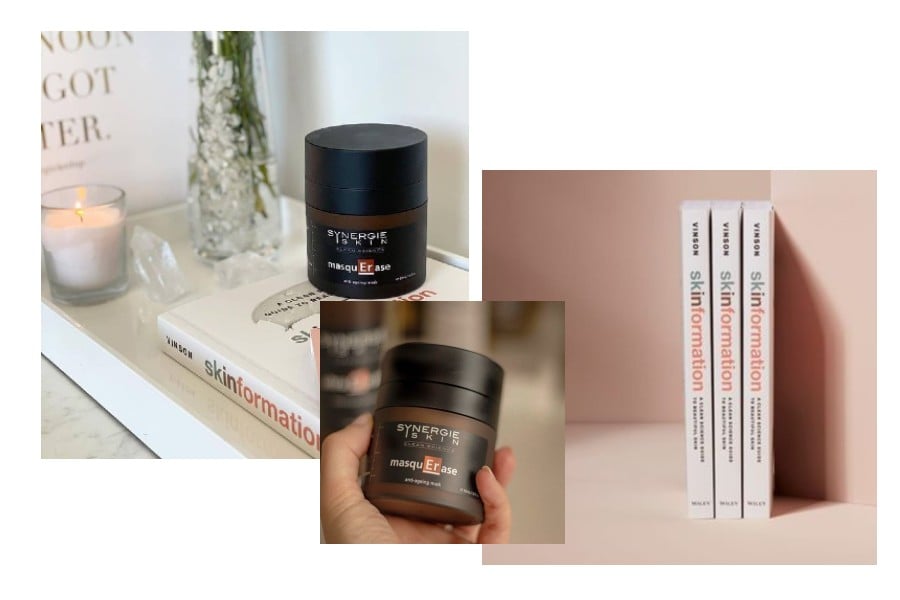
We’re living in the age of skincare and we're certainly not complaining. But with the stampede of beauty trends, savvier marketing teams and a long lineup of new ingredients to get our heads around, it can be difficult to sort what works from what is a waste of time.
It’s unsurprising why we feel this way. It can be an overwhelming task trying to decode the lines of latin gobbledegook on the ingredient labels. Especially when we’re all still trying to figure out what the hell ingredients like retinol and hyaluronic acid actually do. And it’s no secret that the science behind these products can be inaccessible. But why should it be?
We had a read of Terri Vinson’s new book Skinformation. The cosmetic chemist is devoted to clean science and cutting through misinformation in the beauty industry. Her book is an exercise in transparency. She debunks and demystifies the ingredients in our skincare routines so we can approach beauty confident and informed. Vinson also makes a great case for why you should ditch the half-used bottle of toner in your bathroom drawer.
First, some myths
Vinson reminds us that all skincare products should have a full ingredient list either on the product itself or inside the packaging. And when it comes to the ingredients list she says to ignore the urban myth that if it can’t be easily pronounced it’s harmful. Almost all ingredients will have a science-y name because that’s what is legally expected from companies according to the International Nomenclature of Cosmetic Ingredients. For example D-alpha tocopherol sounds like an infectious disease, but is just the required name for Vitamin E.
If in doubt Environmental Working Group is a useful resource to decoding your ingredients list and offer a safety profile too.
The order of ingredients
A handy thing to know when reading the ingredients list on your label is that the ingredients must be listed in order of highest to lowest dosage. Water will normally be listed first as it is a necessary ingredient for serums and emulsions. The ingredients you see as the bottom of the list have the lowest dosage. This is important as oftentimes companies will advertise their products as having life-changing active ingredients, only for them to be added in minute dosages which are often too little to be effective. One more thing to note is that while ingredients like alcohol, lactic acid and sodium hydroxide are harmful in large doses, they can be very useful in the tiny doses needed to make a great product.
What do the ingredients even do?
These are some of the key players in your beauty products:
Solubilisers: Included in products to dissolve one ingredient into another, normally oils in water.
Thickeners: Used to perfect product consistency. Often seen as Xantham Gum, hydroxyethyl cellulose, guar gum and carbomer.
Emulsifiers: Included to avoid separation and provide stability to products containing both water and oil. Clean examples are cetyl alcohol, cetearyl alcohol, stearic acid, cetearyl olivate and sorbitan olivate.
Preservatives: An essential ingredient to prevent the product from contamination by bacteria, mould, yeast and fungi. Preservatives also ensure the shelf life of a product. Essential oils and grapefruit seed extract are not strong enough to be used as sole preservatives. Whereas Benzoid acid, benzyl alcohol, sorbic acid, caprylyl glycol have the tick of approval.
Fragrance: If you’re seeing ‘parfum’ or ‘fragrance’ on your label this usually means the fragrance is artificial. These are the ones you want to avoid if you have sensitive skin, especially as fragrance is considered the most common potential irritant in beauty.
Antioxidants: Antioxidants are key in preventing free radical damage. They also protect the formula from going rancid and keep it stable.
Humectants: These are the hydrating agents that draw water to the epidermis. They come in the form of glycerin, betaince, hyaluronic acid, aloe vera and lactic acid.
Emoillients: These are probably the most recognisable ingredients. They’re the ones responsible for smoothing and hydrating your skin. Some favourites include shea butter, jojoba oil, lanolin and castor oil.
On Toner
As Terri says, “Toners are so ‘80’s and provide zero skin benefit”. They can actually cause more harm than good as the high doses of alcohol in the product can disrupt the surface acid mantle of your skin.
And if you’re using toner to remove those last traces of makeup, Vinson calls us out, telling us to either cleanse more thoroughly or choose a better quality cleanser altogether.
Images: Terri Vinson, Synergie Skin



